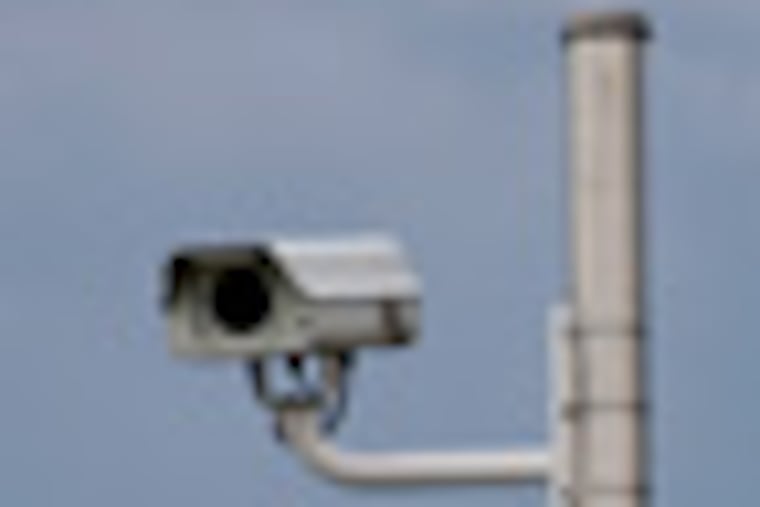Audit criticizes Philly's surveillance-camera project
Citing cameras that function less than half of the time, a price tag of close to $14 million, and a lack of oversight that leaves many pieces of equipment gathering dust in a warehouse, City Controller Alan Butkovitz released a damning audit Wednesday of the city's long-troubled video-surveillance project and suggested that the money would have been better spent hiring more police officers.

Citing cameras that function less than half of the time, a price tag of close to $14 million, and a lack of oversight that leaves many pieces of equipment gathering dust in a warehouse, City Controller Alan Butkovitz released a damning audit Wednesday of the city's long-troubled video-surveillance project and suggested that the money would have been better spent hiring more police officers.
Six years after Philadelphia began installing cameras in high-crime areas, the report found just 47 percent of the cameras functioning as of February.
The $13.9 million poured into the project works out to $136,000 for each working camera, Butkovitz said.
"We have $13 million spent on 100 cameras," Butkovitz said at a news conference Wednesday. "And we could have put 200 police officers on the street."
The audit, performed by an independent accounting firm, comes as the city's murder rate is approaching that of 2007, the year Mayor Nutter was elected on a promise to reduce crime. Butkovitz, who described the recent crime wave as a "crisis," said the cameras have not demonstrably reduced violence.
Everett Gillison, the mayor's chief of staff and deputy mayor for public safety, acknowledged Wednesday that the number of functioning cameras dropped to 35 percent in the fall, when the city hired an outside contractor to do maintenance. Since then, the number of functioning cameras has risen to 67 percent, he said. The city hopes to have 90 percent working by the end of the summer, he said.
"It's not news, quite frankly, that the cameras had gone down," Gillison said. "I don't think that [Butkovitz is] saying 47 percent are not working today. I think he's saying that when he did his report, that's what he found."
Butkovitz said that his office presented the report, which includes information through April, to city officials, but that Gillison offered no rebuttal. Gillison later said the administration's failure to respond formally to the report was "an oversight," thanks in part to budget season in City Hall.
The report recommended that the city consider whether the benefits of the program outweigh the climbing costs. The city has committed to spending an additional $3 million on the project.
The report also described a system of maintenance and oversight in which separate - and conflicting - records were kept by the Police Department and the Office of Innovation and Technology regarding the location and condition of the cameras.
Warranty information is not organized or kept up to date, Butkovitz said, which means the city may have paid outside vendors to repair cameras that were under warranty. And although additional cameras were purchased in 2009, they have been stored in a warehouse in boxes, and it remained unclear whether they were compatible with the existing system, the report said.
Designed as a way to provide police officers with more eyes and ears on the street by capturing images of crime suspects, the cameras have been praised by the city's district captains. Research in Philadelphia and other urban areas has shown that surveillance cameras can help reduce crime.
But the project, which began 2006 as a pilot under Mayor John F. Street, has been plagued with setbacks from the beginning.
An $8.9 million contract was awarded in 2007 to Blue Bell-based Unisys Corp., but shortly after the first cameras were installed, police found that the images were of subpar quality. Interference from buildings and other infrastructure made using a wireless network impossible, and the city switched to a hybrid of wireless and fiber-optic cables.
In 2009, with the project still far from completed, the city ended its contract with Unisys and had the Division of Technology take over.
Gillison said the city had spent $13 million on the program and an additional $3 million on maintenance, money he said was not wasted.
"From my point of view, we've redesigned, given our experience, which is what good leadership actually" does, he said.
Gillison said he had only anecdotal evidence of the cameras' suppressing crime in Philadelphia, mainly because they have not functioned consistently enough to gather data. Police say the cameras can both deter crimes and help solve them. Gillison said they have proved popular in many neighborhoods.
"Everywhere we go in the community, they want more cameras. I have a waiting list of 140 areas that would like to have these cameras in," Gillison said. "I don't have the dollars literally to put them up, but I know I have a lot of people who want them."
He also acknowledged that the benefits might have been overhyped.
"This is not a be-all end-all, and it should not have been sold that way," he said. "This is an additional tool to the police, and I know it is an effective tool."
The goal, Gillison said, is to bring 200 cameras online, and the Police Department is linking with SEPTA and Amtrak cameras, as well as lenses on infrastructure like roads and bridges. Eventually, he said, that could put 1,000 cameras at the department's disposal.
The cameras have also been integrated into the department's Real Time Crime Center, where officers monitor them around the clock.
Deputy Police Commissioner Jack Gaittens, who for years oversaw the Police Department's camera units, said the city was working hard to get the cameras fixed.
"It's easy to look at something and criticize it in hindsight," he said. "But the cameras are a valuable tool that still have great potential for the city."